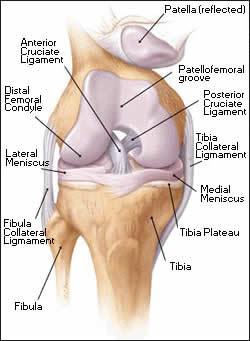


Bristol Knee Clinic

| + home | |
| + news | |
| + research | |
| + patient information | |
| + the clinic | |
| + the surgeon | |
| + sport physiotherapy | |
| + sports advice | |
| + medico legal | |
| + products | |
| + resources | |
| + contact | |
| + maps | |
| + directions | |
| + site map |
The Bristol Knee Clinic |
Patella Tendonitis - Indications / Contra-indications
Anatomy / Ailment detail

The knee comprises the joint between the femur and the tibia but also the joint between the patella and the front of the femur. The two most important groups of muscles supporting the knee are the quadriceps muscle, which is the large bulk of muscle lying at the front of the thigh, and the hamstrings which lie behind the thigh.
The patella is the small bone that sits in the front of the knee to which the quadriceps muscle and the quadriceps tendon attach to its superior pole. Below the patella another tendon connects the inferior pole of the patella to the tibial tuberosity prominence at the anterior aspect of the tibia. The patellar tendon attaches to the anterior aspect of the patella and the inferior pole and runs to the tibial tubercle. The force of the quadriceps extends or straightens the knee. The force of the quadriceps muscle is transmitted to the tibia through the fulcrum provided by the patella. A strong contraction of the quadriceps is also used in decelerating such as when landing from a jump or running down hills. The posterior surface of the patella is covered by the articular cartilage which articulates to the anterior surface of the femur or the femoral trochlea. A fatty pad covers the posterior aspect of the patella tendon, which is called the infra-patellar fat pad.
The inferior pole of the patella in some patients is elongated and this first prompted Mr Johnson to consider if the inferior pole of the patella was one of the causative features of this condition. The morphological and biomechanical studies which were undertaken have suggest that the inferior pole of the patella is not usually abnormal although in some patients the patella tendon is slightly longer in affected patients.
Originally patellar tendonitis was originally thought to be caused by a rupture of the tendon due to a failure of the tendon under tensile overload as a result of repetitive jumping. However the anatomical and biomechanical research undertaken by Mr. Johnson has shown that this condition appears to be caused by an impingement of the patella pressing into the posterior aspect of the upper patella tendon. This is produced when the quadriceps muscle is used "eccentrically" or to decelerate the body in activities such as landing from a jump or when jogging persistently down hills or stairs. The condition is also prevalent in patients undertaking repetitive or long distance driving particularly in four wheel drive vehicles.
Who Needs it / Who Doesn't
Patients with pain around the anterior aspect of the knee in relation to the lower pole of the patella which is troublesome and restrictive to their activities such as sport. The condition may be confirmed by a good clinical opinion, ultrasound or MRI scan. Initial treatment should include a period of rest avoiding the particular activity that produced the condition. Anti-inflammatory medication, regular ice, hamstring stretching and physiotherapy. An infra-patellar knee strap is often also helpful. (link to physio suppliers eg DJortho.com) For recurrent, persistent or restrictive symptoms surgery may be necessary to relieve the condition.
How to arrange an appointment with Mr. Johnson
Your first appointment is usually arranged with Mr Johnson at the Bristol Nuffield Hospital at St Mary's. It is a modern well-equipped hospital with 36 private bedrooms and two operating theatres, and offers a full range of services.
+ How to arrange your first appointment
< BACK to Introduction | NEXT: Non-operative Treatment >
Related Links..
+ Patella Tendonitis - see all links
+ Patient Information Home
+ See the clinic
+ More about Mr Johnson
+ top
© The Bristol Orthopaedics and Sports Injuries Clinic 2003. The Bristol Knee Clinic is a trading name of the Bristol Orthopaedic Clinic Ltd. privacy / copyright | contact | Powered By Create Medical



